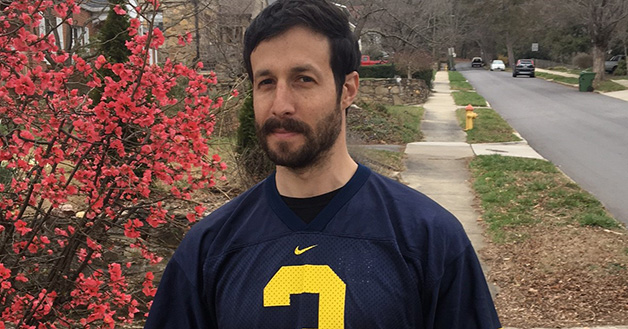I don’t remember exactly where I was when Appalachian State University beat Michigan in September 2007. After graduating in 2005, my Saturdays had become increasingly less free, and I had just moved to New York City a few months earlier. A football victory seemed fairly assured, to put it mildly, so I figured I could miss the game.
I do, however, vividly remember the despondent text chain that alerted me to the upset. The feeling on the thread, which included several other alumni, could be summed up in two ways: “APPALACHIAN STATE!?!?!?” and “@%$#&!” Both captured the sense of shock and disbelief among Michigan fans—and probably most sports fans in general. Still, one must go on, and so I put the ordeal behind me and resolved to forge ahead.
Eventually, however, my past caught up with me. In 2012, I moved to Asheville, North Carolina. The city of around 85,000, the largest in the region, attracts lots of graduates from Appalachian State, which is about two hours away. Before long, I found myself haunted by App State T-shirts, stickers, and other propaganda from that godforsaken institute of higher education—at the Y, around town, idling in traffic while I stared at bumpers. After years of this torment, I started wondering: who are these monsters? And was the game as big a deal in Boone as it was in Ann Arbor?
Last September, I journeyed into the heart of enemy territory to find out. The occasion for my visit was the Mountaineers’ 2016 home opener against Old Dominion University.
As I walked around the small city, a high-elevation mix of Main Street, USA, and hip college town, I struck up conversations with a handful of locals. All of them were suspiciously warm and welcoming, but I knew better. Indeed, at the (packed) Old Dominion game, one elderly gentleman I passed in the concourse revealed his true colors with a shirt that said “Ann Arbor Who?” on the front and “Betcha Know Where Boone Is Now!” on the back. The outrageous boasts traumatized me afresh.
Still, I continued my fact-finding mission. The most common refrain I heard from alumni and fans was that the win “put us on the map.” The second was that finally—finally—people were pronouncing “Appalachian” properly. (For the record, it’s “ap-uh-lah-chin.”)
“After we beat Michigan, we went national,” said Bill Corriher, an App alum and owner of Mountaineer Mania, one of the half-dozen apparel shops within a four-block stretch of downtown. “That summer we had people drive down from all over who wanted to see Boone.” For weeks after the game, T-shirts were all people wanted to buy.
“We had seven different designs,” he said. Judging from my survey of multiple shops, interest in T-shirts has tapered off, but other commemorations to the game can still be spotted all over town. In Macado’s, a restaurant on the main drag, there’s a beatific poster of 2007 Appalachian State coach Jerry Moore being carried on his players’ shoulders just next to the bar.
The win had impacts beyond school spirit, too. Applications to the university spiked nearly 15 percent between 2007 and 2008, and have increased, on average, over 3 percent annually between 2006 and 2015. While a direct correlation is difficult to prove, it seems likely that the so-called “Flutie effect” has been at work, said Michael Trivette, a co-founder of the College Transitions undergraduate admissions consultancy and former App State admissions officer. The phenomenon is named for the jump in applications Boston College received after quarterback Doug Flutie staged a dramatic last-minute win against the University of Miami in 1984.
The downside—apart from millions of shattered Wolverine hearts—is that App State opponents now know what they’re getting into. “We can’t surprise anybody anymore,” said Mary Ann Mallard, a very nice season ticketholder who was finishing up dinner with her husband when I confronted them.
A few days before the game, I spoke to Caroline Faure, an assistant professor at Idaho State University and co-author of the journal article “Pay for Slay: An Examination of the Repercussions of the Big Money Game on the Little Guy in College Football.”
“Without playing those big-money games, many of these schools cannot field a football program or an athletic program,” she told me. Big-money games can also be a powerful recruiting tool. Schools can tell potential players, “Did you see we played at Oklahoma last year, at Michigan this year?”
Not just players are recruited. Trivette credits the Michigan game, at least in part, for App’s invite to Division I FBS and for enticing perennial powerhouse Miami to come up the mountain in 2016. “Make no mistake about it: the Michigan win helped propel this program to new heights and new opportunities.”
I grudgingly considered all of these developments on my drive home from Boone. Hardened though my heart was, I found it gratifying that something good could come from such tragedy. Besides, nearly a decade is long enough to mourn. While Wolverines will never, ever forget, with each new win in the Harbaugh era the weight of that fateful day in September lifts a bit lighter.
Die-hard Michigan fan Adam Rosen, ’05, works in academic publishing in Asheville, N.C.





